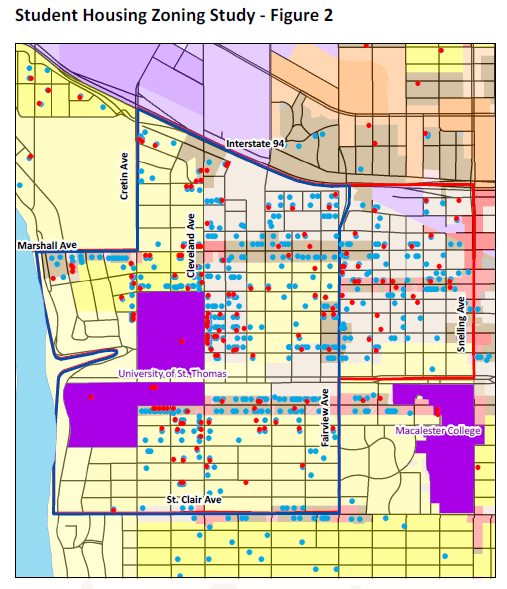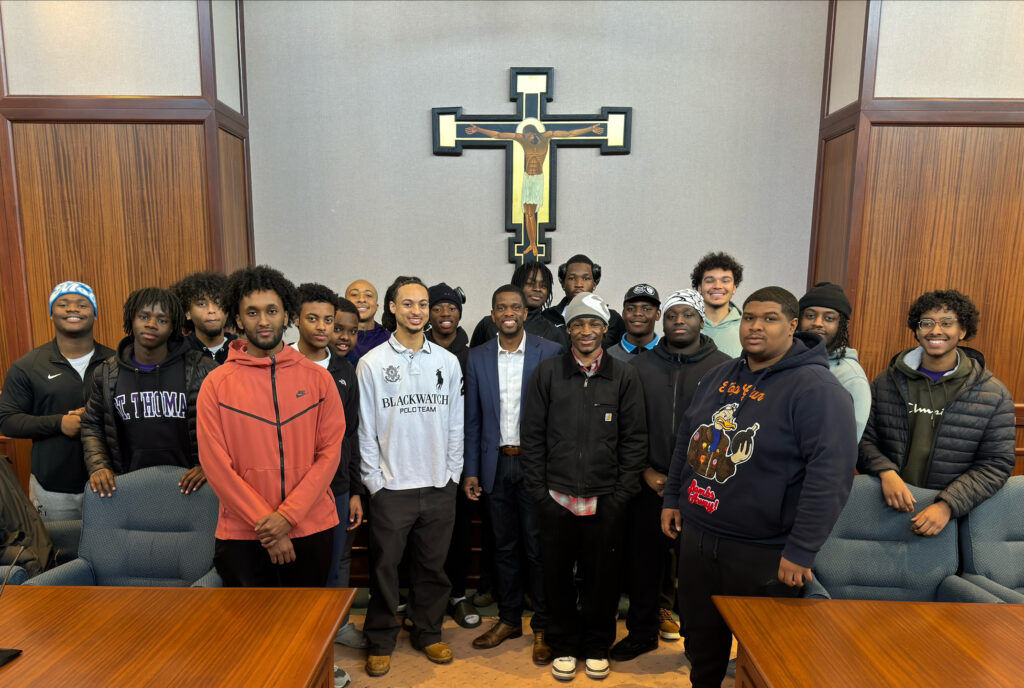A City of St. Paul department has proposed an ordinance to establish a district around the St. Thomas campus to restrict the future conversion of owner-occupied housing to student-rental housing.
The affected area, called a “Student Housing Neighborhood Impact Overlay District,” would require a minimum distance of 150 feet between existing student-rental housing in single-family houses and duplexes and any new student dwellings of the same size.

(click to enlarge) Here is the area where the City of St. Paul wants to restrict the future conversion of owner-occupied housing to student rental housing. The red line is the border for the proposed district, which would be slightly larger (to the northeast) than the area defined by the blue line, where there already is a one-year moratorium on such conversions. The blue and red dots signify student rental properties identified by St. Thomas, the city or both; not all of these properties are occupied only by St. Thomas students.
The district would be bounded by Interstate 94 on the north, Snelling Avenue (south to Summit) and Fairview Avenue (south to St. Clair) on the east, St. Clair Avenue on the south and Mississippi River Boulevard on the west (excluding the Desnoyer Park neighborhood).
St. Thomas has told city officials that it cannot support the ordinance in its current form because it singles out the university, said Doug Hennes, vice president for university and government relations. If the city believes an overlay district represents good policy, he said, it should apply to all neighborhoods surrounding higher education institutions in St. Paul.
“The quality of life in the St. Thomas neighborhood also is of vital concern to St. Thomas, and not just to our neighbors and the city,” Hennes said. “We have been working closely and, we believe, effectively with neighbors and the city to manage issues as they arise, and will continue to do so.”
The Neighborhood Committee of the St. Paul Planning Commission discussed the draft ordinance for more than an hour Wednesday before agreeing to release the ordinance for public review and a May 4 public hearing. If the commission subsequently approves an ordinance, the St. Paul City Council will hold a public hearing in June before making a decision.
The proposed ordinance comes eight months after the council approved a one-year moratorium on the conversion of owner-occupied houses to student rental properties near St. Thomas. The university did not oppose the moratorium because it would have had virtually no impact on students’ ability to find housing for the 2011-12 school year.
The council also ordered city staff to study what, if any, kind of permanent restrictions to impose on future conversions of this type. That study is what led to the proposed density ordinance now under review by the commission.
Neighborhood groups have raised concerns that too many owner-occupied houses near St. Thomas have been sold and converted for rental use by students over the last decade.
“The conversion of housing to student occupancy … has substantially affected the character of the neighborhoods in and around the moratorium area and has had a negative impact on the quality of life for many residents,” states the city staff report. As a result, problems related to traffic, parking, litter, property appearances and student behavior “can have a dramatic, negative impact on neighborhood livability.”
The city report says that the density ordinance “will not reduce the demand for student housing … nor will it address student behavior,” but it can be paired with other efforts to mitigate the impacts of existing student housing.” The report cites steps taken in other cities, including stricter enforcement of housing and fire safety codes, occupancy rules and nuisance ordinances, and the development of more higher-density housing (apartment buildings) near campus.
A study determined that from 2002 to 2009, 129 homesteaded properties (generally owner-occupied) in five several-block parcels near St. Thomas were converted to non-homesteaded status (generally rental), but only 10 properties were converted to homesteaded status. That 13 to 1 ratio is similar to what occurred with property conversions (663 to non-homesteaded and 51 to homesteaded) in a larger neighborhood similar in size to the district proposed for the ordinance.
In 2009, the study further determined, St. Thomas students occupied 26 percent of all properties in the five parcels near campus and 10 percent of those in the larger neighborhood.
The draft ordinance defines a student dwelling as a one- or two-family dwelling requiring a fire certificate of occupancy in which at least one unit is occupied by three or more students. The ordinance would not affect duplexes where the owner lives in one half and rents to students in the other half or housing owned by students.
The ordinance defines a student as an individual who is enrolled in or has been accepted to an undergraduate degree program at a university, college, community college, technical college or trade school and is enrolled during the current or upcoming session or was enrolled in the previous term.
City officials have said they would determine student rental dwellings based on current records and by doing a mass mailing that would ask property owners to self-identify if their properties were student rentals.






